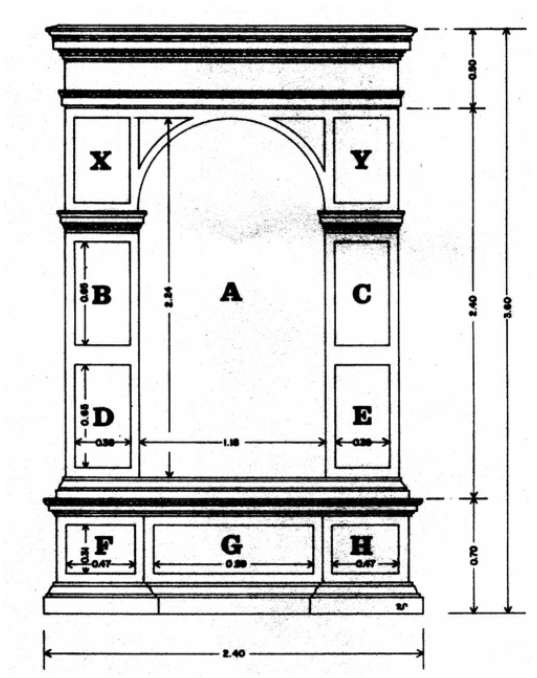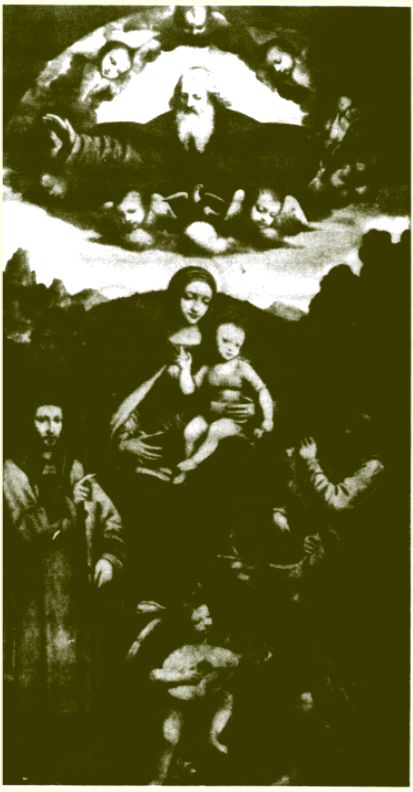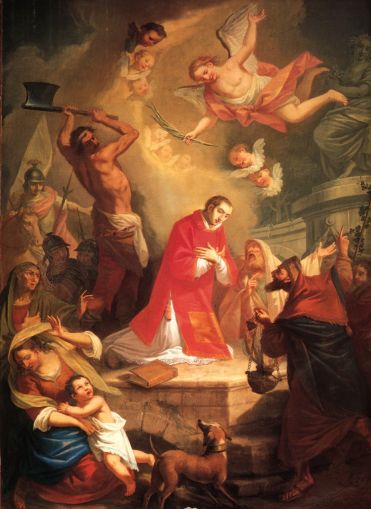|
The Polyptych of Luini |
|||
|
Above the Main Altar of the Church of San Sisinio alla Torre there was once the most famous polyptych painted by the known artist Bernardino Luini (1480-1532), cited in an Inventory of S.Sisinio of the '500 (Archives of the Parish) and later again in the Acts of the visit of mons. Gio. Ambrogio Torriani, Bishop of Como, on 1669, which says: Iconem habet in tabula depictam eleganti manu LUINI PICTORIS factam, B.M.V. Infantem Iesum tenentem ac SS. Laurentii (sic) ET Martini to lateribus martyrio cum S.Sisini Titularis; in part inferior eiusdem Iconis alijs 4 Sanctis procoronide? (AVL, Bottom pastorali visits), that it means:
(There is a painting by PAINTER LUINI which represents the Blessed Virgin Mary holding the Infant Jesus. Saint Lorenzo and Saint Martino are at both sides as well as the martyrdom of S. Sisinio; on the lower part of the same icon (there are) four other Saints, which frame the work).
|
|||
|
|
|||
|
X,Y: Probable Annunciation |
C: Saint Alessandro |
F: The Saints Vows |
|
|
A: Madonna, San Sisinio and Martino |
D: Saint Anna |
G: Ordination, dispute, martyrdom |
|
|
B: Saint Stefano |
E: Saint Caterina |
H: The bodies of the three Martyrs |
|
|
First of all we must rectify that the saint who appears at the left of the Virgin is S.Sisinio in diaconal garments of Ambrosian ritual (and not S.Lorenzo). He is one of the Patron Saints of theChurch (the other two, Martirio and Alessandro, are often forgotten). This is confirmed by the words in golden letters: S. Sixinus and S.Mart.us. On 1524 Bernardino Luini ended his polyptych with the Madonna, the Saints and the history of Martirio, Sisinio and Alessandro, thus abinding by Cristoforo della Torre's will, published on April 16th, 1523. In fact, being ill, Cristoforo della Torre established that his heirs "dentur et numerantur super bonis suis, Ecclesiae sancti Suxeni de Mendrisio, ubi vult sepeliri debere, florenos decem. etc. semel tantum, pro faciendo unam anchonam in dicta Ecclesia et hoc in remedio animae ipsius testatoris" had to give to the Church of S. Sisinio, where he wanted to be buried, ten "fiorini" to make an icon in the Church in memory of the donor's soul. The splendid painting was exposed on 1953 at the exibition of Luini's works at Villa Olmo in Como, partially recomposed for the special occasion. In the year 1793 an important council of the Parish of the Church of S.Sisinio alla Torre, presided by nob.clergyman Agostino Torriani, delegate of the old Prior Carlo Felice Quartironi, decided to sell the great picture at the Main Altar, in the hope of making a good transaction in favor of the poor Church. The sale of this precious picture was a huge mistake. The great value of it was totally ignored or perhaps unknown. The painting, in poplar tables, subdivided in 10 parts, "was sold with the permission of Bishop Rovelli to Mr. Giulio Sacchi of Varese, at the price of Liras 2750, in 1796 ' . All parts of it remained in Milan until 1885, when the lower part (three pieces) and the lateral parts (four pieces) went to two private collections of London and precisely the four Saints Stefano, Alessandro, Anna and Caterina to the Ruston collection, and the lower part, the most beautiful Luini ever painted, with the story of the Saints Sisinio, Martirio and Alesandro, to the Benson collection. Already on 1911 two other parts, that probably represent the 'Annunciation', had been lost.. The central part surely represents the most evocative of the Madonnas painted by Luini; also remarkable is the fascinating placing of the group in the landscape. |
|||
|
|||
|
The lower parts respectively illustrate : the vows, the ordination of the three Saints, the dispute at the altar of Saturn; the killing of Martirio and Alessandro and the Martyrdom of S. Sisinio. Since 1978 the parts of the polyptych went to the following collections: Turin (Di Rovasenda Collection ); New York (Duveev House); Great Britain (Collection of the marquis of Normanby); Philadelfia (Johnson Collection ). Luca Beltrami and arts critic A. Venturi have put highligted the pictorial and artistic value of Luini's table, asserting that ' for the immediate freshness of the illustration, for the poetic landscapes , it is perhaps the more meaningful and complete page of the painter, the one that best introduces him to us'. The four figures of saints, at both sides of the central painting, are remarkable for the wide design that assigns them greateness in spite of the small dimensions of the frames in which the Luini had to contain those figures' ; and also the five frames of the lower part, with the remembered episodes, ' are new testimonies of the facility with which the painter, in spite of the lack of space, carried out and animated the more complex scenes with no trace of triviality wich was so uncongenial to him'. In 1797, in a council of the Parish della Torre, it was explained that part of the sum perceived from the sale of the painting was used in order to pay for another large painting' ( the actual one of cm 220 x 315) placed above the Main Altar, a beautifu oil by Giovan Battista Bagutti of Rovio (1742-1823).
It represents the martyrdom of S. Sisinio, painted by Bagutti while he was at the peak of his artistic activity. |
|||


